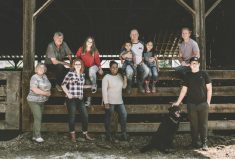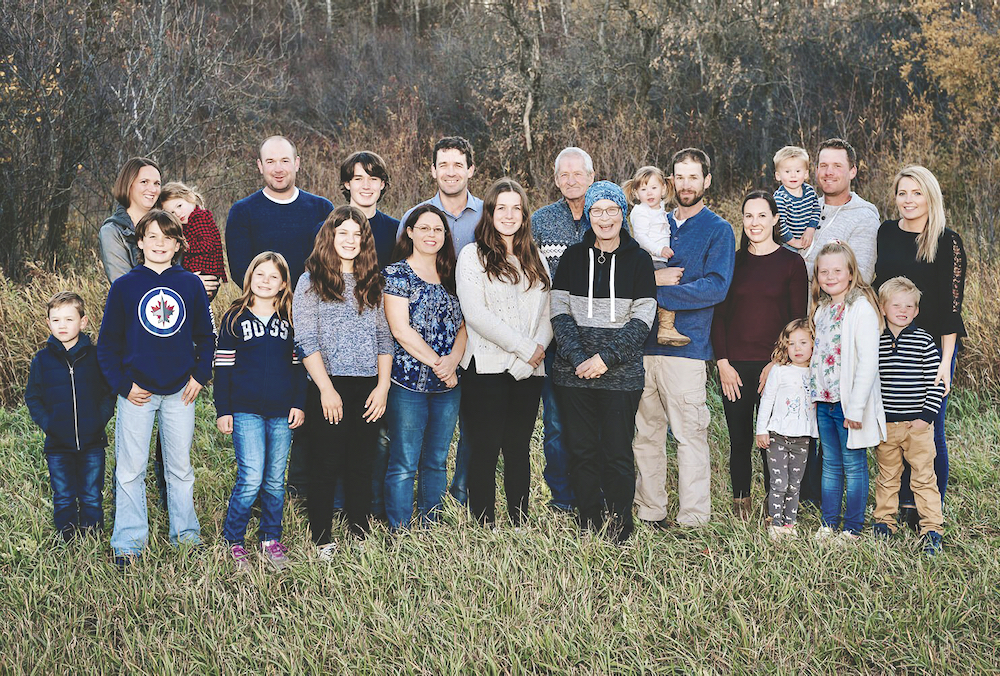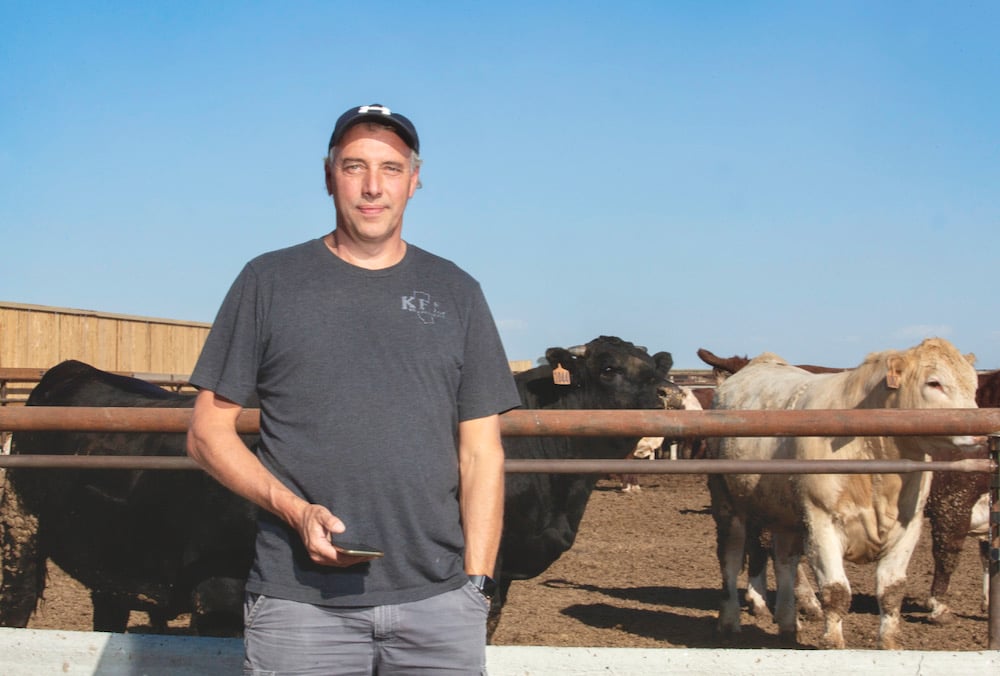It’s the classic Western Canadian love story. Boy and girl meet at a hockey game. Years later, they meet again at Alberta’s Ukrainian Pysanka Festival in Vegreville. They fall in love, they marry, they move back to his family’s farm, and they start a family.
Also, like so many farming couples, Brian Headon and Rhonda Zuk Headon have complementary skills that make them a farming powerhouse. Rhonda is a savvy direct-marketer with a passion for homegrown food. Brian has a financial shrewdness that serves them both well.
Read Also

Farmland values: assumptions and realities
Where farmland values are headed and what decisions farmers should make
Together they have diversified the farm, running separate businesses that tap into commodity and local food markets.
High-stakes yearling business
In 1972, Brian’s grandparents started a dairy near Kitscoty in Alberta, just west of Lloydminster. They soon expanded into cash crops.
Two generations later, Brian still manages much of that land, but the Headon farm now looks very different than it did 40 years ago.
Today Brian buys yearling cattle, grazes them through the summer, and then sells them in the fall through an online auction. He also runs a Flaman franchise, renting equipment such as skid steers and rollers.
Running yearlings isn’t for the faint of heart, Brian concedes. “You’re basically playing the market as much as raising beef, whereas with cow-calf, you’ve got a little bit more cushion.”
Brian can speak at length about farm finance. He clearly has a passion for the subject, and he is confident in his knowledge. Plus he has a plain-language approach that makes it easier for a listener to understand.
Brian always knows the market value of his yearlings. Last fall, “the day I went to sell, they just weren’t where I thought they should be,” he says. So he called “no sale.”
Shortly after, the cost of gain started dropping and Lloydminster’s Vee Tee Feeders had pen space available. Brian listed them again for a December 1 delivery. The wait made a difference. Only three weeks later, he got a “stellar price.”
But Brian didn’t get those steel nerves overnight. He has invested time in learning about economics and financing, and he keeps an eye out for what works well for other producers.
Brian was 17 in the late ’90s when the farm’s dairy quota was sold and the land was split. He earned a journeyman license in heavy-duty mechanics and worked in the local John Deere dealership while raising cattle and growing grain with his parents, Debbie and Brian Sr.
Brian knew taking over the family farm wouldn’t be a stroll in the pasture. Markets were more bear than bull at the time, but he sought ideas to make the land more profitable. His neighbour practiced holistic management, and the idea of grass-based production started to appeal.
“You’re not really dependent on the input suppliers,” Brian says. Focusing on grass meant changing his mindset because he wouldn’t have the cash flow that he would on a grain farm. But neither would he have the overhead, fixed expenses, or direct costs.
To survive, Brian says, “You have to set it up so it’s a very low input system. So at the end of the day you’re going to net likely more money and not have the stress.”
Brian also looked abroad for ideas he could apply at home. Visiting dairies in New Zealand revealed how much value a grass-based production system could generate. New Zealand dairy farmers exported powdered milk at that time, so production was seasonal.
Although Canada’s winter is frigid, the growing season isn’t much shorter than New Zealand’s, Brian says. And cold, dry winters preserve swath and corn grazing, giving Canadian livestock producers an advantage.
But Brian knew he had to bump up his business management skills. He convinced his father to take the Ranching for Profit course with him. At that time, the course cost them about $4,500 each, and government funding wasn’t available to offset the costs.
The intense week-long course was worth the hefty price tag, Brian says. “We came out of that course after a week and it was just kind of like a new world.”
Brian Sr. knew he didn’t want to manage the business, so he made a point of handing the reins to his son. Both Brian Sr. and Debbie have been slowly exiting the business since, although Debbie ended up being more involved in 2013, due to some unexpected labour issues.
The course gave Brian and his dad the confidence to seed 2,400 acres of grain land to grass over three years. Brian then bought yearlings to feed out.
Brian also picked up some specific approaches to financial management that have served him well. For example, when it comes to measuring his operation’s financial health, Brian leaves land equity out of the equation “so then you’re calculating your gross margins on your production. And your overhead’s away from your direct costs. You get a very clear picture of what your business is really doing.”
A Bud Williams Stockmanship Course taught him to sell existing inventory before replacing it. “You have to sell your tractor first, know what you’ve really got for it from the market. And then you go back to the market and you try to purchase what’s undervalued.”
The Ranching for Profit course also had an ongoing executive link. They created a board of directors that sat down with the Headons and provided feedback on the business. “It’s fairly intimidating at times. But yet it’s kind of reassuring because they’re looking at your financing, your economics,” Brian says.
These days Brian buys yearlings in late February, feeds them for about 100 days, then grazes them in 20-acre paddocks, where they’re rotated frequently. He doesn’t worry too much about specific breeds or colours, but instead focuses on the potential price differential. He also tries to buy uniform bunches so they’ll gain at about the same rate.
Brian also studies market reports and talks to Don Davies at Vee Tee Feeders. He punches prices into a customized spreadsheet for each weight class, plus fat cattle prices and cost of gain. He knows his cost of production and what kind of margin he needs. “That kind of determines what we run.”
Brian initially thought about direct marketing grass-finished beef. “But when we ran the numbers, it’s just easier to run a bit more of a commodity mindset and have the economies of scale.”
Although the markets have been kind to him recently, Brian doesn’t come across as smug. Despite all the preparation, Brian says it was a tough go when he first started buying yearlings. He made mistakes, and the price differentials were tight.

“So it was probably the worst it could be, but yet sometimes it’s good, I think, to have those failures early on because then you’re a little bit more cautious,” Brian says.
Brian has had near misses, too, and is considering the Cattle Price Insurance Program offered by Agriculture Financial Services Corporation (AFSC).
The beef recall of 2012 could have hurt him. But Brian had pre-priced his yearlings in June, for a late-September delivery, avoiding the price drop.
He says 2013 was a wake-up call because after calling no sale, he had no price protection on his calves.
“All it would have taken was another repeat of the year before, where all of a sudden some plants get shut down and this market crashes. Well then you’re left holding a big bag. And there isn’t that kind of margin in it.”
Brian has no regrets about the changes he’s made over the last decade. The farm is more profitable, and even more family-friendly than its previous incarnation. “There isn’t too much that we do without our kids around,” he adds.
More from the Country Guide website: Fearless financing
Farm girl grows up in the city
Although Rhonda grew up in Edmonton, both sets of her grandparents had mixed farms south of Vegreville. She set down roots in the prairie soil, becoming an agronomist for Sturgeon Valley Fertilizers.
Much of Rhonda’s passion for her business is rooted in her love of making food, instilled in her by her maternal grandmother. But it wasn’t until she took a trip to Italy to mark her 30th birthday that she was inspired to learn the craft of cheese-making.
She initially went for three months, but it wasn’t enough. Podere Il Casale, a Tuscan farm that made wine, olive oil, and cheese from its own raw ingredients, lured her back like a siren calling sailors to a reef. Rhonda returned home to rent out her condo, quit her job, and make other arrangements.
“When I went over to make the cheese, it was never intended to become a career. It was just to be able to say, ‘I know how to make cheese,’” she says.
Something about the farm, where the farmer owners interacted directly with customers, often over supper, inspired her. Rhonda started telling people she was thinking of starting a cheese-making business. They took her seriously, and so she felt obligated to do it, she says, laughing.
But Rhonda and Brian were an item by this time. She wasn’t sure if his parents would embrace the idea of a cheese-making business on their family farm.
It turns out they not only supported it, the family farm financed her plan when the banks wouldn’t. And so The Cheesiry was born.
But being a cheese-maker isn’t all fun and glamour.
“It’s a tough startup business. That’s for sure,” says Rhonda.
Rhonda speaks quickly. I get the sense she has tons of energy, and a good thing, too. As she takes me through a day in the life of a cheese-maker, I realize just how labour-intensive it is.
Rhonda and her staff bring in the milk sometime between 6:00 a.m. and 6:30 a.m. to warm it up before adding the culture. What follows are hours of cutting, agitating, and reheating curds and whey before they’re poured into moulds to form cheese. The cheese is incubated at about 30 C to sweat out the whey. It’s also flipped every 15 minutes while it sweats.

The Cheesiry’s biggest risk is bacteria in the cheese. Their feta, Camembert, fresco and yogurt are made from pasteurized sheep milk, but the hard cheeses are formed from raw milk and is aged for at least 60 days. Cleanliness is the first line of defence, so they spend two hours washing equipment after each batch. Each batch is also lab-tested before it’s released for sale.
Rhonda had trouble securing dairy quota, as she only wanted to milk seasonally. So she turned to sheep, which ended up being a selling point for customers with dairy allergies.
She now relies on 120 ewes for milk, and their health and productivity is another risk. “Every year we ultrasound the sheep. And I just think, what if we don’t have sheep pregnant this year. What if half the flock’s not pregnant? That’s a big risk.”
Rhonda also faced distribution problems when she started up. She wasn’t able to sell in the farmers markets because of the raw milk cheeses. She had to rely on cheese shops and restaurants to buy her cheese. And although she moved all the cheese, some of it didn’t sell immediately.
“We had two-year-old cheese, which is great, but at the same time, you want that cash flowing a little bit sooner,” she says.
The shops were a relatively stable market, but chefs were constantly leaving the restaurants, forcing Rhonda to continually re-market her products.
Rhonda’s passion for the business has helped sustain her through the rocky first few years. And although it’s still a tough trek, things are improving. A regulation change allowed Rhonda to sell her cheese in Alberta’s farmers markets last year, giving her a more stable market. And she has good advisers, too. When it comes to cheese production questions, Rhonda turns to Margaret Morris at Glengarry Cheesemaking. And Brian helps her with business management questions, plus provides moral support.
And although the farmers markets are time-consuming, the customer interaction is inspirational. Rhonda likes introducing the cheese to reluctant customers, who think it’s going to taste like mutton (it doesn’t). “That always makes me happy,” says Rhonda. “It’s nice to get that feedback right from people who are eating your product that you’ve actually spent the time to produce.”
Rhonda’s business doesn’t see the same returns as Brian’s yearlings do, and it’s more work. But Rhonda controls her destiny, just as she controls the production, processing, and marketing. Local consumers also offer a stable market, which balances the more volatile commodity market Brian works in.
The Cheesiry remains a tough business to run. The more cheese they produce, and the more markets they access, the more labour that’s required. “I still don’t feel like we’ve hit the mark in terms of (it being) smooth sailing.”
But Rhonda is optimistic about the future. She’s working with a university in France to employ exchange students in the summers. She hopes to line up quota so she can start a new cheese line blending cow and sheep milk.
And cheese-making allows her to indulge her creative side. In Italy, she added lavender to her cheese, which won over the initially skeptical Austrian cheese-maker and farm owner. Next summer she plans to introduce a Nutella-fresco blend to Alberta’s foodies.
Shared labour
Brian and Rhonda’s businesses are separate entities, but they have some synergies, especially when it comes to labour.
Rhonda’s business attracts labour, which is a big plus, especially since the Headons now have toddler twins and Brian’s parents are moving towards retirement.
Along with the university students from France, potential employees contact Rhonda through her website, thecheesiry.com.
The Headons provide housing, a vehicle (which employees have to insure), and food, along with a wage. They also generally pay a bonus at the end of the season.
Staff members handle much of the day-to-day production work, and to help them, the Headons have created procedure manuals, grazing maps, and contact phone lists.
But it’s not always easy. Last year, a family emergency forced an employee to quit partway through the season. The Headons hired more help to pick up the slack, but found retraining someone for a short time inefficient. They learned they are probably better off adjusting their systems in such situations, Brian says. They’ve also kept one of their seasonal interns employed this winter so she’ll be fully trained when the busy season hits.
Despite the hitches around sharing labour, “I think the benefits do far outweigh any negatives that we’ve had,” says Brian.
Employees often get more than a wage and boarding out of the deal. One year a Vancouver woman apprenticed with Rhonda to improve her cheese crafting. The cheese-maker also brought along her boyfriend, who worked with Brian.
“He had no small-hand-tool experience whatsoever,” Brian says. “Yet when he left we had him welding.”
The Headon family farm is prospering these days, thanks to the diverse businesses Brian and Rhonda have brought in. But, like many farms, the focus is as much on people’s well-being as much as business because that, they seem to show, can be one of the great outcomes of diversification on the family farm.
















